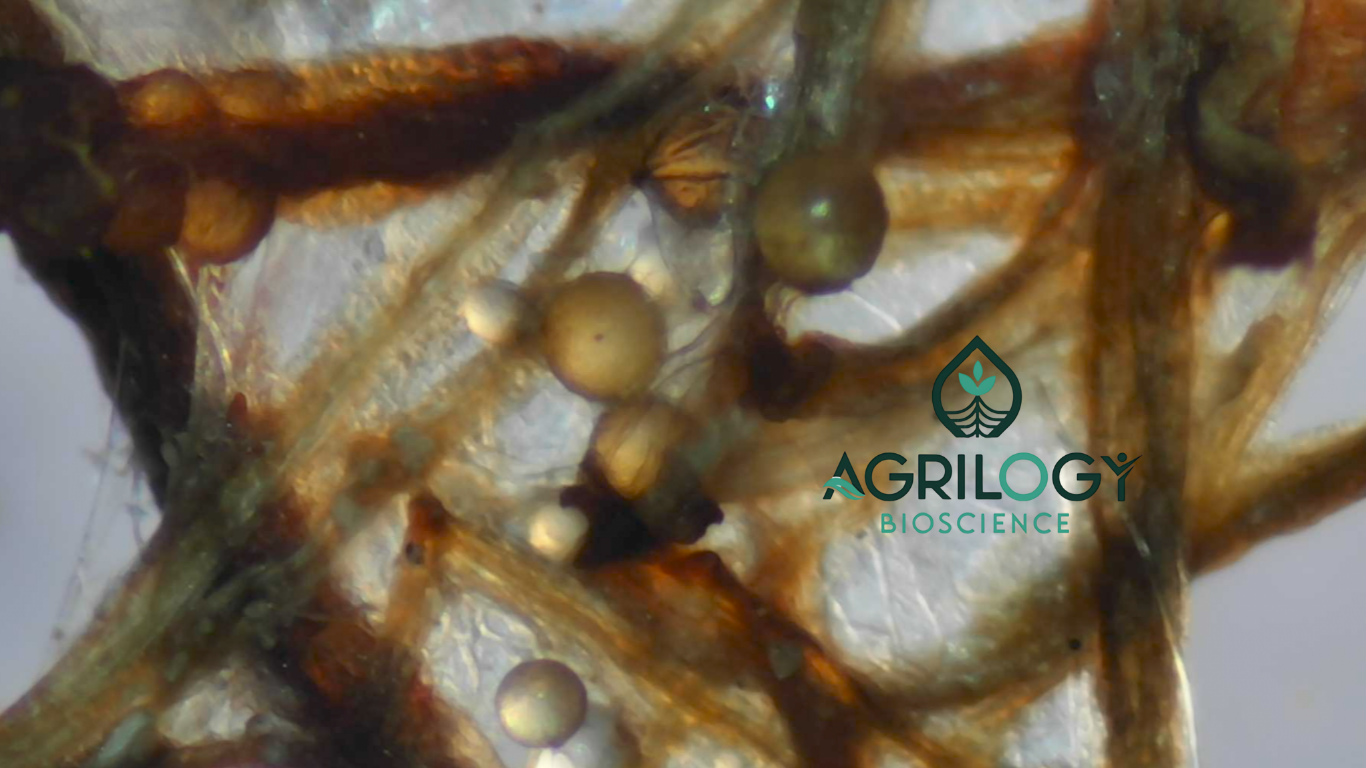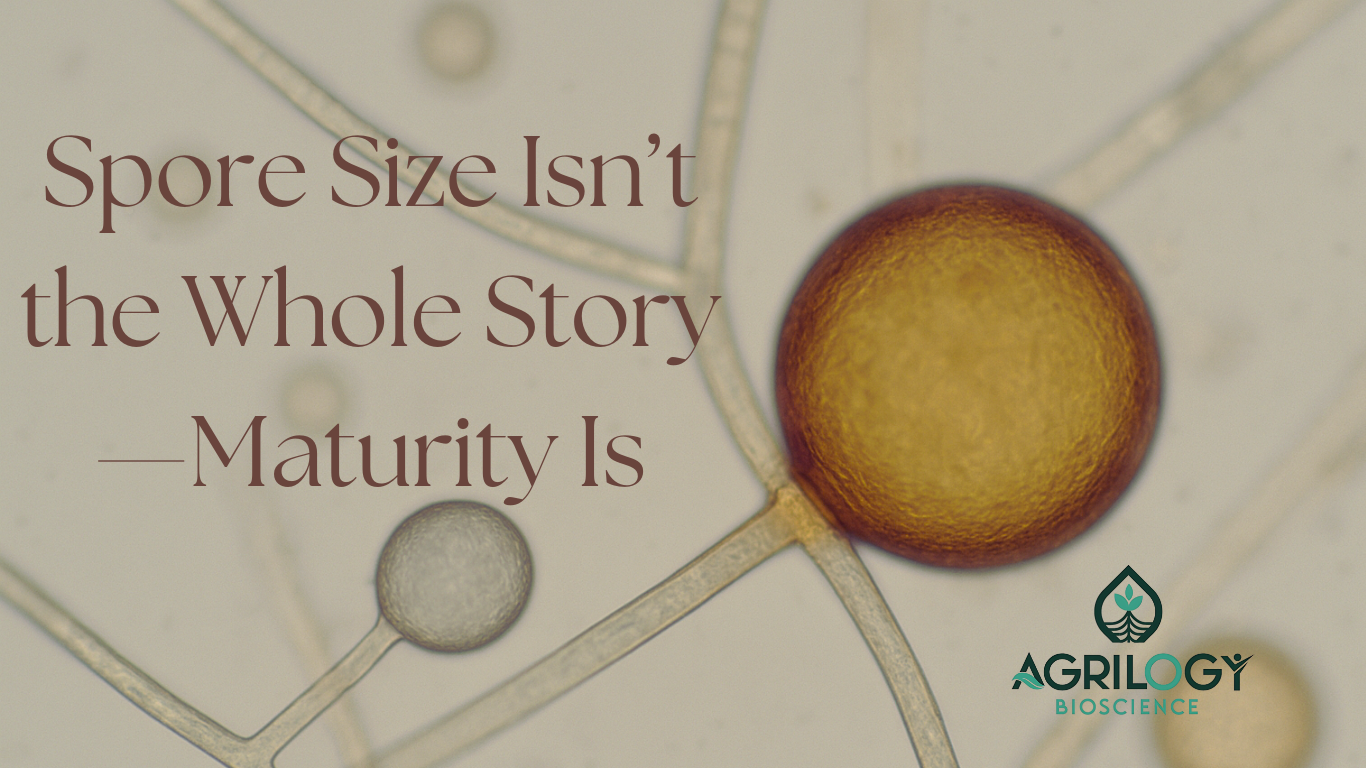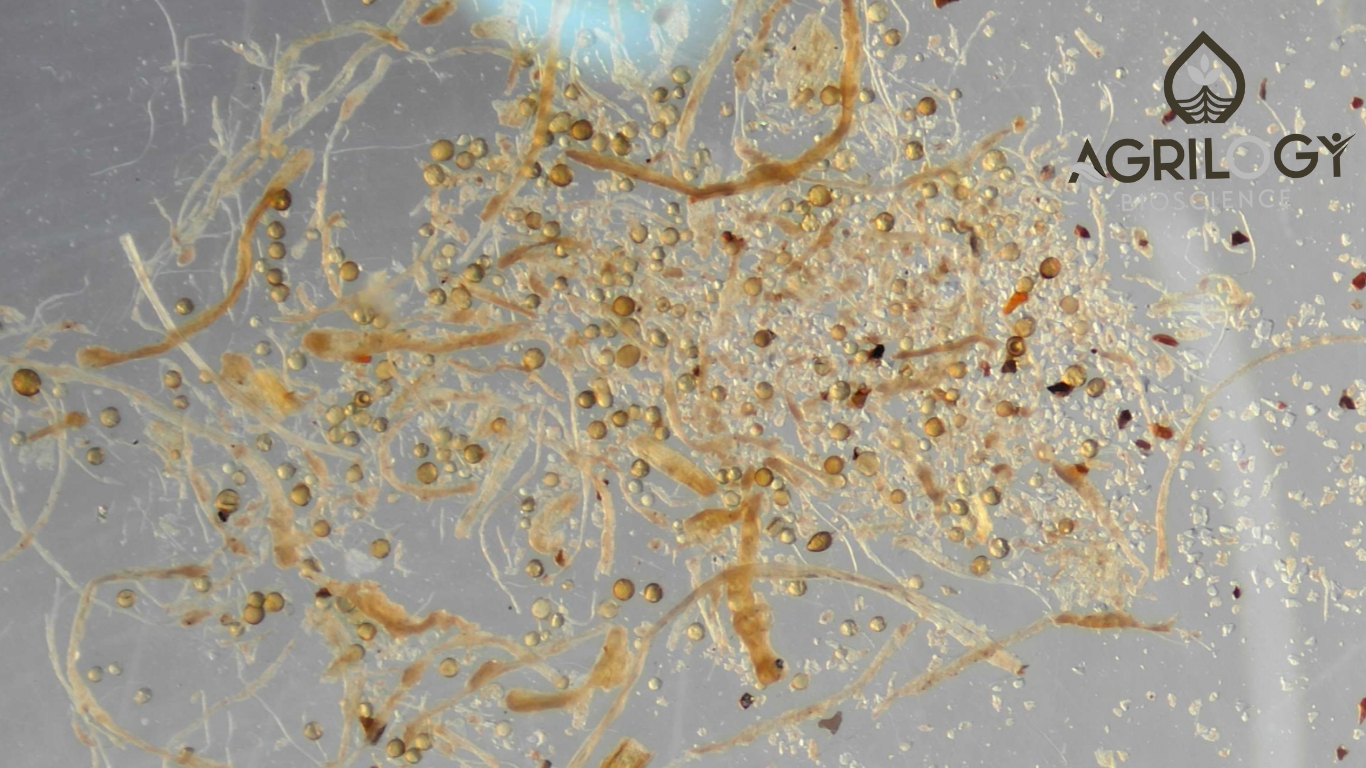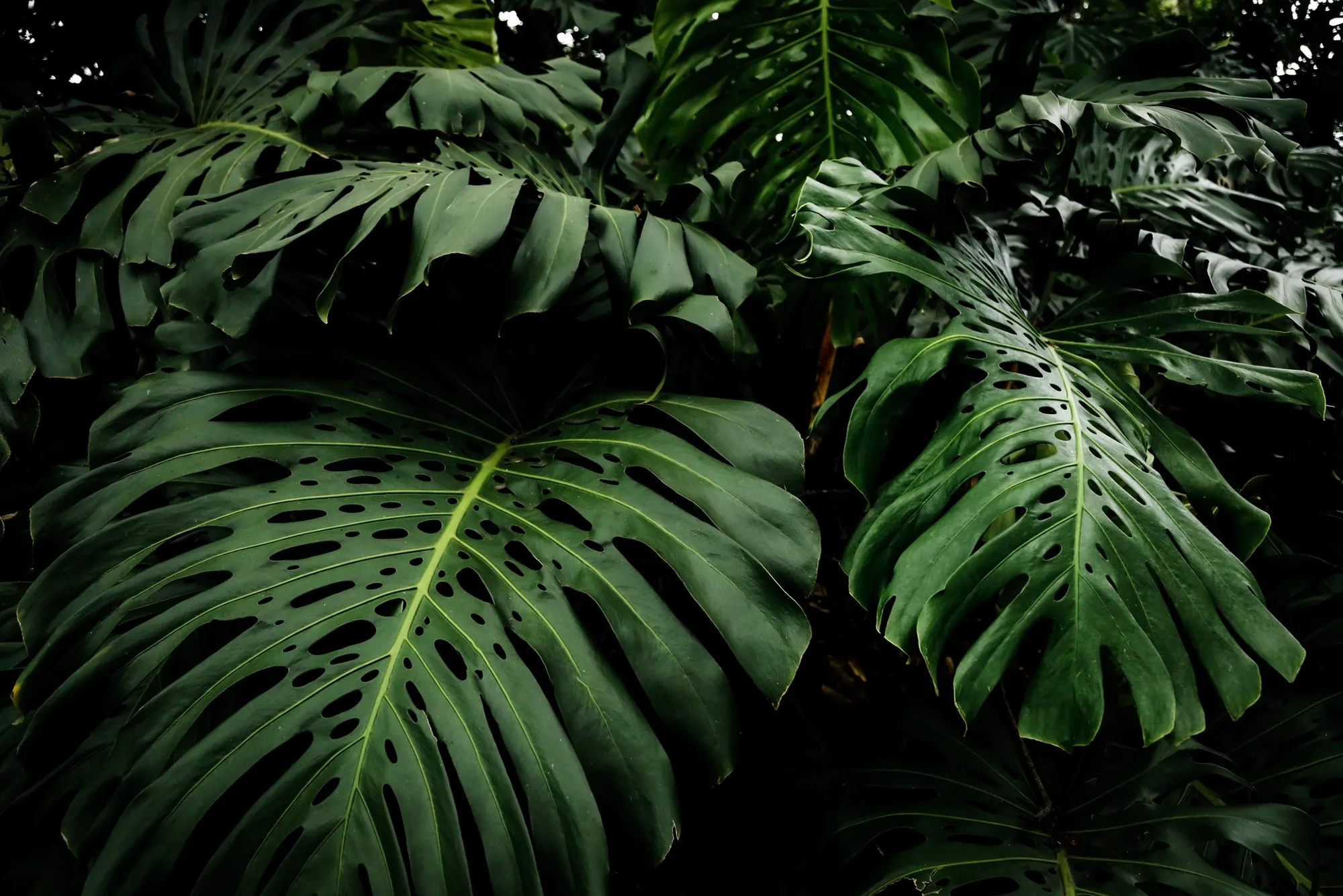
Golden Is Good… But So Are White and Pale Yellow Spores—Here’s the Science
A Story from the Farm That Opened Everyone’s Eyes
A farmer once visited our field demo carrying two samples of mycorrhiza spores.
One had golden-yellow spores—bright, shiny, and visually impressive.
The other had white and pale-yellow spores—simple, dull, easy to underestimate under microscopy.
He asked:
“Saheb, aa banema thi kayu sachu kaam karse? (Which one will work better?)”
Almost everyone pointed to the golden spores.
But the soil told a different story!
When we tested both samples:
- Some golden spores did not stain in the MTT assay → meaning they were dormant or old
- The white and pale-yellow spores turned deep blue hue→ showing strong viability and active metabolism
- Pale spores colonized roots more quickly
- Field plots with pale spores showed better early growth and stronger root networks
The farmer was surprised.
But this is exactly what the science says: Golden spores are good—but white and pale-yellow spores are equally good, often even more active.
Why Colour Alone Misleads Us
A mycorrhiza spore’s colour—whether white, pale yellow, cream, or golden—naturally varies due to its genetics, the host plant it grew with, the soil and environment it developed in, its age, and the carotenoid pigments in its outer wall. Because these factors influence only the outer appearance, colour alone cannot indicate a spore’s internal health or viability. Just like wheat grains that differ slightly in shade but grow equally well, mycorrhiza spores also show harmless colour variation. The real indicator of quality is not colour, but whether the spore is alive and capable of colonizing roots.
White and Pale-Yellow Spores: Naturally Efficient Contributors to Soil Health
White and pale-yellow AMF spores are not weak or immature—multiple authoritative sources, including INVAM (International Culture Collection of Arbuscular Mycorrhizal Fungi) and GINCO-BEL (Belgian Glomeromycota Collection), document that many well-known, highly functional AMF species naturally produce spores in lighter shades. These pale-coloured spores belong to species that play a strong role in nutrient mobilization, hyphal spread, soil aggregation, and root colonization, often performing as effectively as darker or golden spores. AMF reference databases also show clear evidence that pale-coloured spores are common in Glomeraceae and other agriculturally important families, where colour variation is considered a normal taxonomic trait, not a sign of poor quality.
Because of this natural diversity (Polymorphism), pale and white spores consistently contribute to soil ecology by improving phosphorus and micronutrient uptake, enhancing water-use efficiency, increasing soil microbial activity, and supporting carbon storage through extensive hyphal networks.
Thus, the presence of white or pale spores in a product is fully aligned with natural AMF biology and reflects the diversity found in verified, curated AMF collections worldwide.
Myth vs. Reality: Colour Does Not Indicate Viability
It is a common belief that yellow or golden spores are always viable and white or pale spores are non-viable, but MTT assays and global AMF references show this is not true. Golden spores often fail to stain in MTT because they may be senescent, dormant, or pigmented in a way that limits dye penetration, meaning their colour alone cannot confirm activity or viability. In contrast, white and pale-yellow spores frequently stain deep blue, indicating active metabolism, healthy cytoplasm, and readiness to germinate.
So the reality is clear:
Yellow spores are not automatically viable, and white/pale spores are not automatically non-viable. Viability depends on the internal physiology of the spore, not its colour.
What Actually Determines Spore Quality?
Real quality depends on:
- Germination ability
- Cytoplasmic health
- MTT viability
- Hyphal growth
- Root colonization %
- Infection points
- Field performance
Not on colour.
Colour only tells appearance—not power.
Appearance Isn’t Quality: Rethinking AMF Procurement Standards
For procurement teams, judging spore quality by colour alone may seem simple, but it causes significant hidden losses. When white or pale-yellow spores are rejected purely because they don’t “look” ideal, procurement unknowingly discards many viable, high-performing spores that global AMF collections such as INVAM and GINCO-BEL consider completely natural. This leads to avoidable batch rejections, reduced usable output, higher production costs, and inconsistent final product quality.
Colour-based filtering also increases the risk of supplying farmers with visually appealing—but biologically weaker—products. By removing pale spores that often show strong metabolic activity in tests like MTT, procurement unintentionally reduces the overall viability of the formulation. This undermines field performance and long-term trust in the brand.
Moreover, rejecting pale spores deprives the soil of beneficial fungi that contribute to nutrient uptake, root development, and soil structure. These losses highlight why global AMF experts do not use colour as a quality parameter. Procurement accuracy improves dramatically when decisions are based on functional viability, germination, and colonization ability, rather than superficial appearance.
What Should Be Practical Action Check List?
1. Update Procurement SOPs
Adopt the natural colour range of AMF spores — white, cream, pale yellow, and light golden — as acceptable and normal variations.
2. Train QC & Field Teams
Clarify that lighter spores are not weak; they are natural and often show higher metabolic activity in viability tests.
3. Educate Farmers in Simple Terms
Use farmer-friendly explanations such as:
“Spore nu rang quality nathi batavtu; MTT ma neelo rang jivant spore batave chhe.”
4. Follow Science-Based Quality Checks
Rely on MTT viability, germination, and colonization efficiency, rather than colour-based selection.
5. Promote Soil-Health–First Communication
Show how pale spores improve nutrient uptake, root strength, and long-term soil fertility year after year.
Spore Colour Is Just Nature; Viability Is the Truth
Golden spores are good.
White spores are good.
Pale-yellow spores are good.
Every colour is simply a part of nature’s diversity—and all can support strong roots, healthy soil, and better crops. What truly matters is viability, not appearance.
It’s time to move beyond colour myths and build a future driven by science, soil health, and honest quality standards that deliver real value to farmers.
Because ultimately…
Crops don’t grow from the colour of the spore—they grow from the life and activity within it.
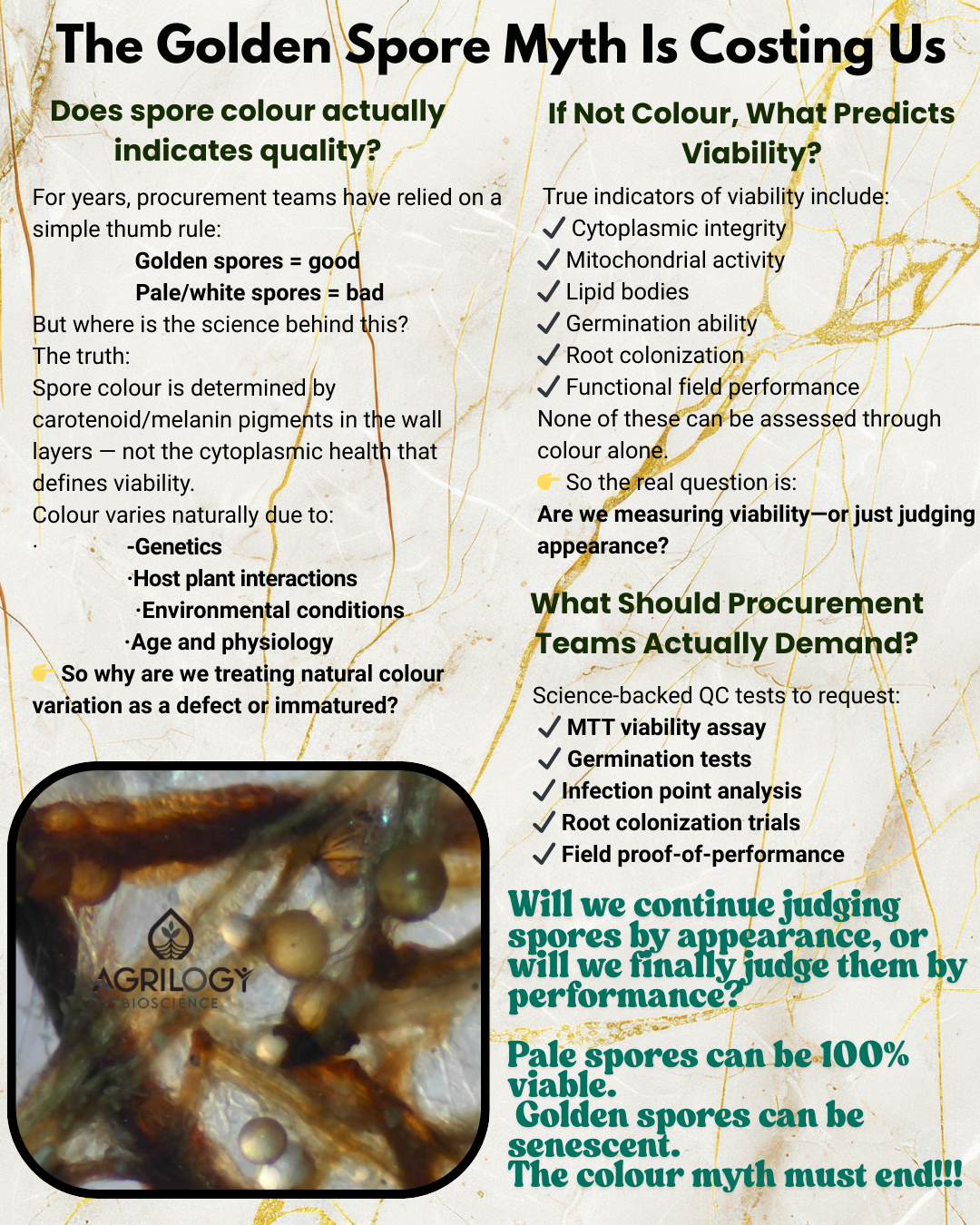
Small but Mature! The Difference Between Natural Size and Immaturity in AMF Spores
Why spore size alone can’t tell you the whole story?
Have you ever bitten into a fruit too early? A mango that’s still hard and sour, or a banana that’s green and starchy? You know instantly—it wasn’t ready. But what about cherries or berries? They’re small, yet perfectly sweet when ripe.
AMF (Arbuscular Mycorrhizal Fungi) spores work a lot like fruits. Some are naturally small but ready for action, while others are small because they’re still growing. The real trick is knowing the difference.
Small by Nature vs. Small by Immaturity
Small by Nature
Just like cherries are small but ripe, some AMF species (Glomus clarum, for example) always make small spores—60–100 µm in size. They may be tiny, but they’re complete, mature, and capable of doing their job.
Small by Immaturity
Other species (Gigaspora gigantea) are designed to grow big—up to 400 µm. If you find one of its spores at only 100 µm, it’s like biting into a half-grown mango. It hasn’t yet packed in the nutrients, energy reserves, or protective walls it needs. In short: it’s unfinished.
The Spore’s “Coming of Age” Story
Every spore goes on a journey, almost like a child growing into an adult:
- The Baby Stage – A little swelling appears at the fungal tip.
- The Teenager – It grows rapidly, storing lipids and sugars, bulking up, but still fragile.
- The Young Adult – Its wall hardens into multiple protective layers.
- The Independent Adult – It cuts ties from its fungal parent and becomes its own strong, viable unit.
If you find it in the teenage stage—it looks smaller, softer, and isn’t ready to take on the world.
Signs of an Immature Spore
Under a microscope, immature spores reveal their secrets:
- Smaller than the normal size of its species.
- Thin or translucent wall.
- Watery cytoplasm with few oil droplets.
- Still attached to the fungal parent.
- Cannot germinate properly.
Why Does This Matter?
- For Science: Avoid inflated spore counts.
- For Farmers: Only mature spores actually help crops.
- For Ecology: A wave of immature spores often means fungi are actively reproducing, usually after rain or fresh carbon from roots.
The Big Picture
Not every small thing is incomplete. Some spores are born small and strong. Others are only temporarily small because they’re still developing. Just like fruit, the difference between “ripe” and “unripe” changes everything.
- For researchers, this means accurate counts.
- For producers, it means honest quality control.
- For farmers, it means inoculum you can truly trust.
In the end: it’s not the size of the spore that matters—it’s whether it’s ready for the job.
Farmer’s Analogy Box: Spores = Fruits
- Cherries (Small but Ripe) → Naturally small spores (Glomus clarum) → Mature and ready.
- Mangoes (Big, Unripe when Small) → Immature spores (Gigaspora gigantea) → Still developing.
Takeaway: Don’t judge by size alone—judge by readiness!
Why Spore Size Matters in Mycorrhizal Fungi ?
The hidden trade-off between survival, dispersal, and ecosystem success
The Basics: What Are We Talking About?
Endomycorrhiza (AMF): These are fungi from the phylum Glomeromycota that live in partnership with the roots of over 80% of land plants.
The Spore: For AMF, spores are the primary survival and dispersal unit. Each spore is a tiny capsule packed with hundreds to thousands of nuclei, lipid reserves, and the potential to start life again by colonizing a p
lant root when conditions allow.
Why Spore Size Matters
Spore size is not random. It’s an evolutionary trade-off between two competing needs:
- Small spores → High numbers, easy dispersal.
- Large spores → Better survival, more reserves.
This balance explains why AMF are so successful in almost every terrestrial ecosystem.
Genetic Blueprint: Different Families, Different Sizes
Each AMF species has a “signature” spore size.
- Acaulospora and Entrophospora → Small to medium spores (40–200 µm).
- Gigaspora and Scutellospora → Giants (300–800 µm, sometimes visible to the naked eye).
The Survival vs. Dispersal Trade-Off
- Large spores
- Pros: Store more food, survive drought or poor soils, grow long germ tubes.
- Cons: Costly to make, fewer in number, poor wind dispersal.
- Small spores
- Pros: Cheap to produce, countless in number, move easily with water, wind, or animals.
- Cons: Less energy stored, short shelf life, need to land very close to a host plant root.
Environmental Drivers
- Nutrient-poor soils: Favor larger spores for survival.
- Disturbed ecosystems (e.g., farms): Favor smaller spores for rapid recolonization.
- Host plant health: Stressed plants may force fungi to produce fewer/smaller spores.
Ecological and Practical Implications
Soil Health Indicator
Shifts in spore size reflect ecosystem status.
- Dominance of small spores → disturbance, intensification, or degradation.
- Large spores → stability, maturity, and resilience.
Agricultural Inoculants
- Small spores: Best for commercial use. They can be mass-produced, flow in irrigation systems, and mix with seed coatings.
- Large spores: Less equipment-friendly but ideal for forestry, orchards, or revegetation projects needing long-term establishment.
Dispersal Across Landscapes
- Small spores: Travel vast distances via wind and water (even between continents).
- Large spores: Spread locally, often hitchhiking with earthworms, rodents, or other soil movers.
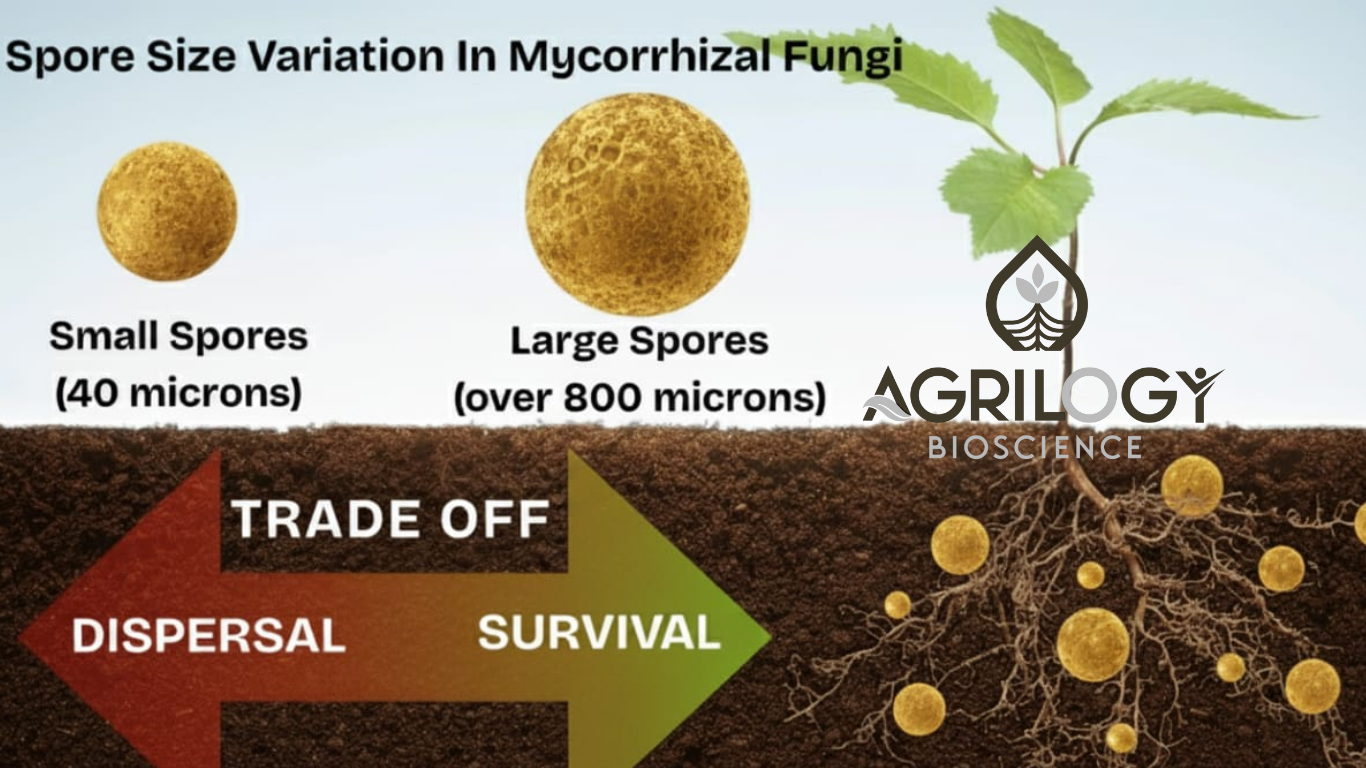
Fascinating Twist: Spore Clusters
Some AMF species combine both strategies by producing spore clusters (sporocarps).
- Example: Glomus species form clusters of many small/medium spores.
- Advantage: Protection plus the ability to disperse multiple spores at once via animals or disturbance.
The Bigger Picture: r- vs K-Strategies
In ecological terms:
- Large spores = K-selected strategy → “quality over quantity.”
- Small spores = r-selected strategy → “quantity over quality.”
This simple size difference drives the resilience and spread of one of Earth’s most important plant-fungal partnerships.
The Bottom Line
Spore size is not just a microscopic detail—it’s a survival strategy. It shapes how fungi spread, endure harsh conditions, and support the plants we rely on for food, forests, and healthy ecosystems.

